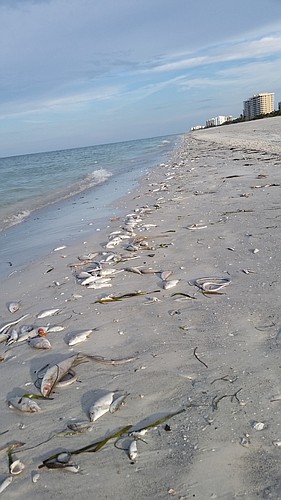- May 16, 2025
-
-
Loading

Loading

A persistent batch of red tide continues to assault Longboat Key with smells and dead fish.
Fish kills affecting multiple species, along with respiratory irritation for humans, have been reported in Manatee and Sarasota counties since Sept. 19.
Longboat Key crews are cleaning canals again Monday, reports Town Manager David Bullock. More than 55 tons of dead fish have already been removed from island canals and shoreline during the seven weeks of the latest outbreak, which has ebbed but never completely released its grip on the island.
“With the continuing presence of dead fish, we have continuing canal cleaning and continuing citizen calls,” Bullock said in an email Monday afternoon. “As long as there is red tide out there, expect more dead fish and more cleaning and more phone calls. Any other expectation is unrealistic.”
The latest Florida Wildlife Commission report on Friday showed a bloom of the red tide organism, Karenia brevis, persists in Southwest Florida ranging from Pinellas to northern Collier County.
Karenia brevis was observed in very low to medium concentrations in 11 samples collected recently from Manatee County and low to high concentrations in 28 samples collected recently from Sarasota County.
Bullock said new pockets of red tide are addressed as they form and are found.
“Dead fish show up wherever the wind and tide and location of the kill take them,” he emailed.
AshBritt Environmental Inc. of Deerfield Beach was hired to clean Longboat Key's red tide kill in 2015. The town paid $32,711 for removal of dead fish from canals Nov. 20-22, Nov. 25 and Dec. 1.
Bullock has had Public Works crews remove dead fish from the beach and canals since Oct. 1. The approximate cost so far has been $3,700, according to Mark Richardson, Longboat Key streets, facilities, parks and recreation manager.
According to the FWC, red tide is a naturally occurring microscopic alga documented almost every year somewhere along Florida’s Gulf Coast since the 1840s. Red tide begins 10 to 40 miles offshore and is transported inshore by winds and currents, according to FWC. It can cause respiratory distress in humans and is toxic to several species of fish and mammals.